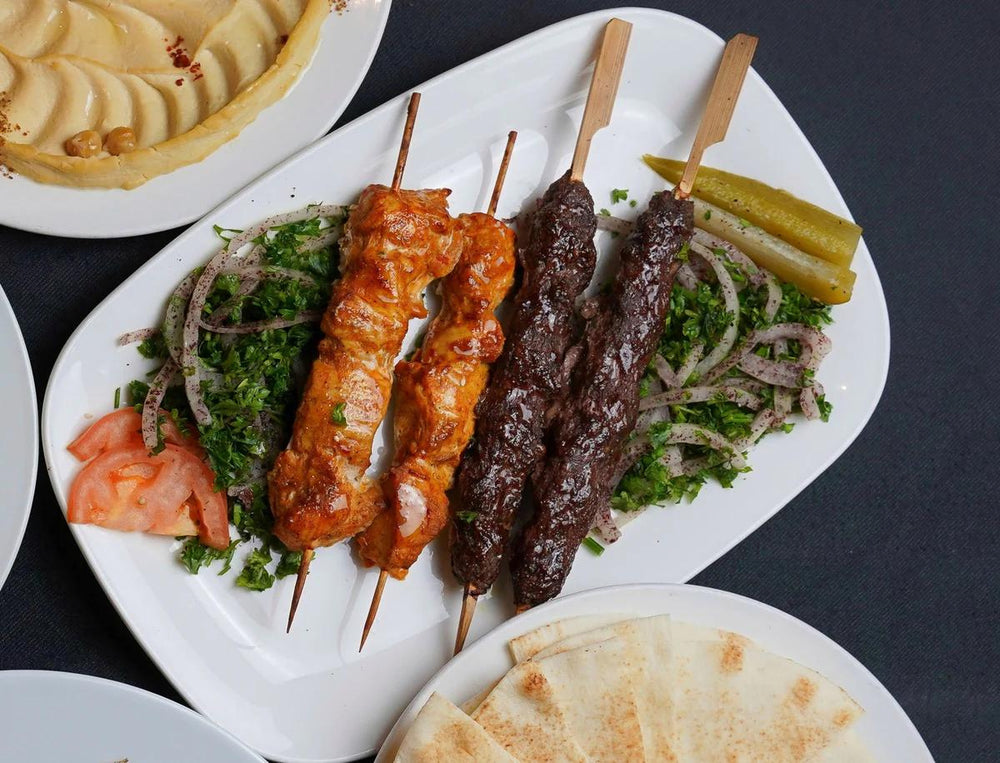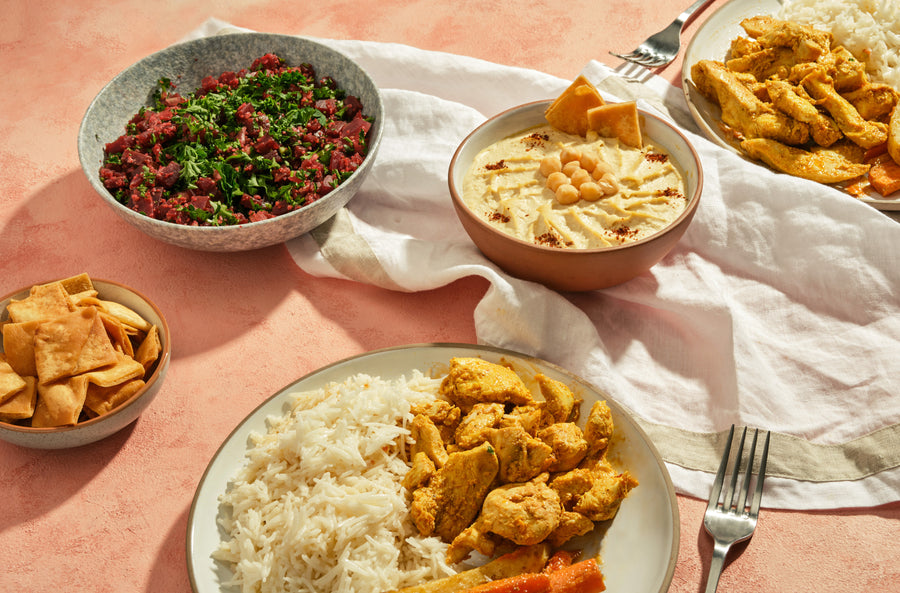A Deep Dive Into Syrian Cuisine: Recognizing Its Cultural Value and Halal Aspects
Syrian cuisine symbolizes an abundant tapestry of historic narratives and cultural influences. Each dish tells a story of community and practice, emphasizing the value of shared dishes. The adherence to halal techniques not just reflects spiritual beliefs however additionally shapes the identity of Syrian cooking. As international occasions test these culinary traditions, the durability of this cuisine remains a prime focus of cultural preservation. What exists behind the tastes that specify this withstanding heritage?
The Historical Origins of Syrian Food
Although Syrian cuisine has actually progressed over centuries, its historic origins are deeply intertwined with the area's diverse social influences. Situated at the crossroads of different civilizations, Syria has absorbed culinary techniques from the Phoenicians, Greeks, Romans, and Ottomans, to name a few. This rich tapestry of background has actually added to a food defined by a blend of flavors, seasonings, and food preparation methods. The fertile lands of the region have additionally played a crucial role, offering an abundance of grains, fruits, and vegetables that develop the foundation of several recipes. The intro of new ingredients through profession and conquest even more improved the culinary landscape, permitting the growth of distinct local specialties. Additionally, the impact of bordering nations has resulted in a vibrant exchange of cooking ideas, strengthening Syria's setting as a considerable player in the broader context of Center Eastern gastronomy.

Typical Syrian Dishes and Their Cultural Significance
Standard Syrian meals are not only cooking staples however likewise lug deep cultural value, showing the country's abundant heritage. Iconic dishes, usually prepared during joyful occasions, serve as a way of joining households and communities. These recipes embody the tastes of Syria while strengthening social bonds with shared celebrations and practices.
Iconic Syrian Staples
When exploring the abundant tapestry of Syrian food, one uncovers a range of iconic recipes that not only tantalize the taste buds but also symbolize the nation's cultural heritage. Among these staples, Kabsa attracts attention as an aromatic rice recipe, frequently experienced with flavors like saffron and cardamom, signifying friendliness. Fattoush, a lively salad made with combined greens and crunchy bread, shows the significance of fresh active ingredients in Syrian cooking. Muhammara, a spicy dip made from peppers and walnuts, showcases the rich tastes characteristic of the area. Additionally, Kibbeh, a recipe made from bulgur and minced meat, is commonly considered as a national treasure, representing communal gatherings. Each recipe narrates, connecting people to their roots and customs.
Festive Dish Practices
Syrian cheery meal customs are rich with significance and value, as families collect to celebrate vital celebrations with the sharing of precious meals. Dishes often showcase a selection of typical foods, with recipes like mansaf, tabbouleh, and kibbeh taking center phase. Each meal carries cultural history; as an example, kibbeh, made from bulgur and minced meat, stands for friendliness and abundance. During Ramadan and Eid, households prepare special desserts such as maamoul, representing pleasure and unity. These celebrations promote area bonds, as sharing a dish represents love and togetherness. The preparation and pleasure of these dishes mirror Syria's varied culinary heritage, linking family personalizeds and local impacts, therefore improving the festive experience and preserving cultural identity.
The Function of Family Members and Neighborhood in Syrian Food Society
Food serves as a crucial thread that weaves together household and community in Syrian culture. Meals are often communal experiences, where households collect around a table to share standard dishes that reflect their heritage. The prep work of food is a public task, with generations working side by side, giving dishes and food preparation strategies. This practice strengthens familial bonds and promotes a feeling of belonging within the community.Special occasions and spiritual parties better highlight the relevance of food in Syrian society. During these occasions, family members prepare elaborate meals that serve not only to nurture however additionally to express love and friendliness. The act of sharing food signifies unity and assistance among neighbors and close friends, strengthening social ties. Through these shared cooking experiences, Syrians grow a strong identification rooted in their abundant cultural background, illustrating exactly how food transcends simple food to end up being an important component you can try here of their social textile.
Halal Practices in Syrian Food Preparation
In the context of communal dishes and family members gatherings, halal practices play a substantial role in Syrian cooking. These practices come from Islamic nutritional laws, making certain that food is prepared and eaten in a manner that straightens with faiths. For numerous Syrian family members, adherence to halal principles affects various aspects of meal preparation, from sourcing ingredients to cooking methods.Animals used for meat needs to be butchered according to details standards, highlighting humane treatment and conjuring up the name of Allah. Additionally, cross-contamination with non-halal items is thoroughly stayed clear of in both home cooking areas and industrial establishments.This dedication to halal not only shows spiritual commitment but also promotes a feeling of area, as families frequently come together to share dishes that honor these practices - Brunch Kitsilano Vancouver BC. Halal techniques are deeply woven into the material of Syrian cooking culture, shaping both daily life and festive events.
Active Ingredients That Define Syrian Tastes

The significance of Syrian cuisine is shaped by a harmonious blend of essential seasonings and herbs that boost its unique tastes. Standard cooking techniques further elevate these components, showcasing the abundant culinary heritage of the area. A summary of crucial components reveals the foundational function they play in producing genuine Syrian dishes.
Key Flavors and Natural Herbs
A dynamic tapestry of flavors identifies Syrian food, with crucial spices and herbs playing a crucial role in specifying its essence. Popular amongst these are cumin, coriander, and sumac, which offer deepness and warmth to various dishes. Cumin, with its nutty scent, frequently improves stews and barbequed meats, while coriander adds a citrusy note to salads and dips. Sumac, understood for its appetizing taste, lightens up dishes and is regularly sprayed over fattoush or kebabs. Furthermore, cinnamon and allspice give a refined sweetness, frequently discovered in both full-flavored and pleasant preparations. Fresh herbs like mint, parsley, and dill are additionally essential, More Bonuses using a ruptured of quality and balancing the rich, intricate flavors that make Syrian cuisine one-of-a-kind.
Typical Food Preparation Techniques
Food preparation strategies in Syrian cuisine reflect an ingrained tradition that enhances the tastes of its ingredients. Approaches such as slow-cooking and braising are generally utilized, allowing herbs and spices to blend beautifully with meats and vegetables. Cooking, especially over charcoal, imparts a great smoky splendor to meals like kebabs, while steaming is typically utilized for rice, preserving its appearance and taste. Furthermore, sautéing is preferred for preparing aromatic bases, typically starting with onions and garlic to build deepness. Fermentation contributes in producing unique flavors, noticeable in recipes like pickled veggies. These methods not just highlight the quality of ingredients but also personify the common spirit of cooking, bringing families together around shared dishes soaked in custom.
Vital Ingredients Summary
While exploring Syrian food, one rapidly discovers that vital components play a critical function in specifying its special flavors. Olive oil, a staple, gives richness and deepness, commonly functioning as a base for lots of recipes. Fresh herbs, such as mint, cilantro, and parsley, add vibrant aromas and preferences, enhancing the general experience (Brunch Kitsilano Vancouver BC). Seasonings like cumin, coriander, and cinnamon are often utilized, including heat and intricacy to meals. Furthermore, Syrian cuisine heavily incorporates grains, particularly bulgur and rice, which serve as basic components in numerous dishes. Pulses, especially chickpeas and lentils, offer both nourishment and appearance. Together, these ingredients create the harmonious equilibrium that defines Syrian recipes, showing the country's rich cooking heritage and cultural relevance
The Effect of War on Syrian Cooking Customs
Although the battle in Syria has wrought devastation across the nation, its influence on cooking customs exposes an intricate interaction of resilience and adjustment. As neighborhoods dealt with variation, conventional dishes were customized because of the shortage of sources and components. Family members commonly depend on locally readily available produce, including new tastes and techniques right into their dishes, which resulted in the introduction of distinct analyses of traditional dishes.Moreover, the war fostered a spirit of uniformity among displaced cooks and home cooks, who shared their cooking understanding with social media and community kitchens. This sharing of recipes not only managed cultural heritage yet likewise produced a sense of belonging amongst those affected by the conflict. Regardless of the hardships, the enthusiasm for food stays a unifying force, permitting individuals to maintain their identity and get in touch with their roots, also in expatriation. Syrian cuisine continues to advance amid hardship, showing both an abundant history and contemporary durability.
Frequently Asked Inquiries
What Prevail Cooking Techniques Used in Syrian Food?
Common food preparation techniques in Syrian cuisine consist of grilling, baking, sautéing, and cooking. These techniques enhance flavors and textures, enabling the production of diverse dishes that more information mirror the area's abundant culinary heritage and traditions.
Exactly How Has Globalization Influenced Syrian Food?

Are There Vegetarian Options in Standard Syrian Dishes?
Vegetarian alternatives are prevalent in conventional Syrian meals, including components like veggies, lentils, and chickpeas. Popular recipes such as Mujadara and Falafel emphasize this variety, suiting different nutritional choices while preserving the rich tastes of the cuisine.
What Beverages Set Well With Syrian Meals?
Drinks that pair well with Syrian dishes consist of mint tea, pomegranate juice, and ayran - Brunch Kitsilano Vancouver BC. These drinks complement the flavors of traditional meals, improving the dining experience while supplying stimulating contrasts to the rich, mouthwatering tastes
How Do Syrians Commemorate Food During Holidays or Festivals?
Syrians commemorate food throughout vacations and events with intricate feasts, typically featuring typical meals. Family members gatherings highlight sharing dishes, signifying unity and social heritage, while unique deals with and desserts highlight the joyful spirit and communal joy. Typical Syrian meals are not just culinary staples yet likewise bring deep social importance, mirroring the country's abundant heritage. When checking out the abundant tapestry of Syrian food, one discovers a range of legendary dishes that not just entice the taste buds yet also symbolize the nation's social heritage. Syrian festive dish traditions are abundant with importance and relevance, as families gather to celebrate crucial events with the sharing of beloved meals. Cooking methods in Syrian food reflect an ingrained practice that improves the tastes of its components. Vegan choices are widespread in conventional Syrian meals, including ingredients like lentils, veggies, and chickpeas.
Comments on “Syrian Cuisine: A Halal Journey Through Flavor and Faith”